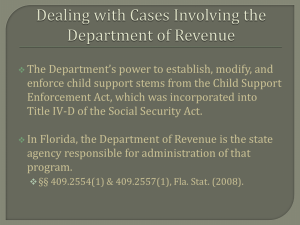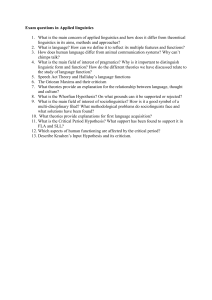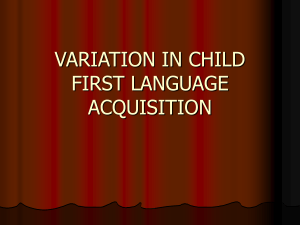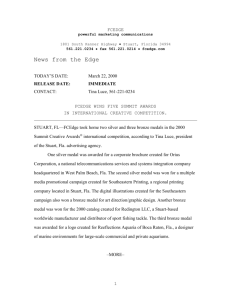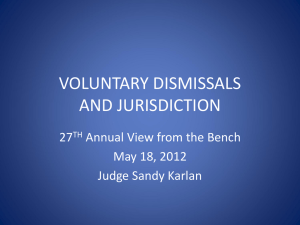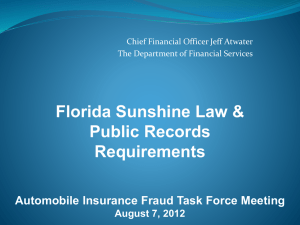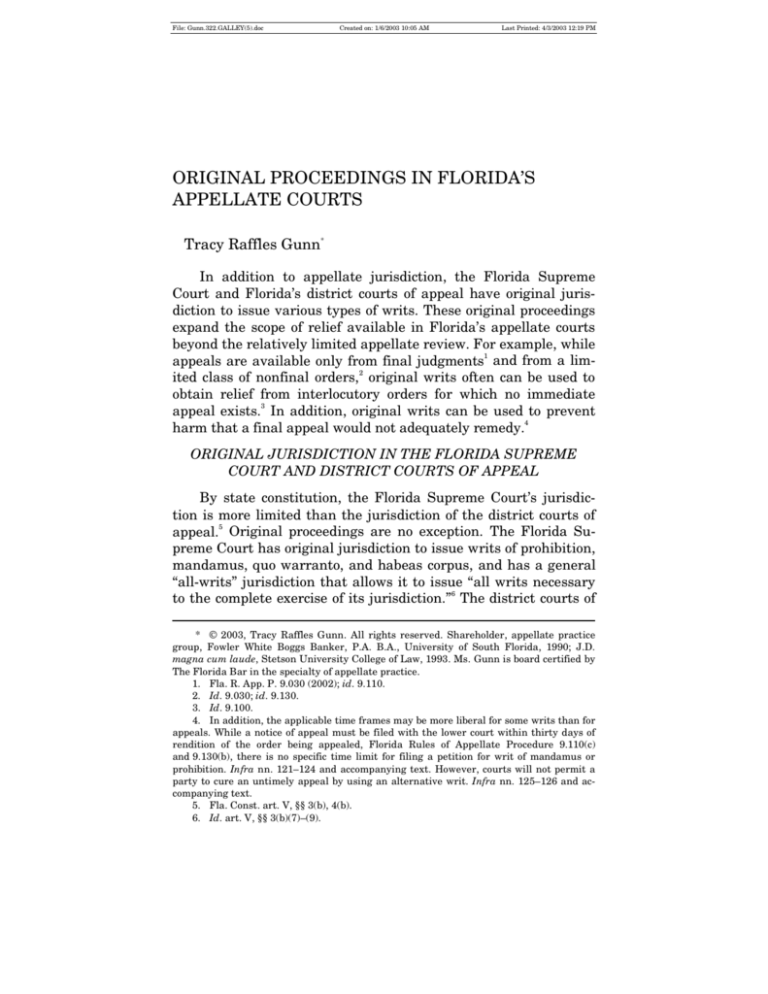
File: Gunn.322.GALLEY(5).doc
Created on: 1/6/2003 10:05 AM
Last Printed: 4/3/2003 12:19 PM
ORIGINAL PROCEEDINGS IN FLORIDA’S
APPELLATE COURTS
Tracy Raffles Gunn*
In addition to appellate jurisdiction, the Florida Supreme
Court and Florida’s district courts of appeal have original jurisdiction to issue various types of writs. These original proceedings
expand the scope of relief available in Florida’s appellate courts
beyond the relatively limited appellate review. For example, while
1
appeals are available only from final judgments and from a lim2
ited class of nonfinal orders, original writs often can be used to
obtain relief from interlocutory orders for which no immediate
appeal exists.3 In addition, original writs can be used to prevent
4
harm that a final appeal would not adequately remedy.
ORIGINAL JURISDICTION IN THE FLORIDA SUPREME
COURT AND DISTRICT COURTS OF APPEAL
By state constitution, the Florida Supreme Court’s jurisdiction is more limited than the jurisdiction of the district courts of
5
appeal. Original proceedings are no exception. The Florida Supreme Court has original jurisdiction to issue writs of prohibition,
mandamus, quo warranto, and habeas corpus, and has a general
“all-writs” jurisdiction that allows it to issue “all writs necessary
6
to the complete exercise of its jurisdiction.” The district courts of
* © 2003, Tracy Raffles Gunn. All rights reserved. Shareholder, appellate practice
group, Fowler White Boggs Banker, P.A. B.A., University of South Florida, 1990; J.D.
magna cum laude, Stetson University College of Law, 1993. Ms. Gunn is board certified by
The Florida Bar in the specialty of appellate practice.
1. Fla. R. App. P. 9.030 (2002); id. 9.110.
2. Id. 9.030; id. 9.130.
3. Id. 9.100.
4. In addition, the applicable time frames may be more liberal for some writs than for
appeals. While a notice of appeal must be filed with the lower court within thirty days of
rendition of the order being appealed, Florida Rules of Appellate Procedure 9.110(c)
and 9.130(b), there is no specific time limit for filing a petition for writ of mandamus or
prohibition. Infra nn. 121–124 and accompanying text. However, courts will not permit a
party to cure an untimely appeal by using an alternative writ. Infra nn. 125–126 and accompanying text.
5. Fla. Const. art. V, §§ 3(b), 4(b).
6. Id. art. V, §§ 3(b)(7)–(9).
File: Gunn.322.GALLEY(5).doc
348
Created on: 1/6/2003 10:05 AM
Stetson Law Review
Last Printed: 4/3/2003 12:19 PM
[Vol. XXXII
appeal likewise have mandamus, prohibition, quo warranto, ha7
beas corpus, and all-writs power. They also have broad jurisdic8
tion to issue writs of certiorari.
The extraordinary writ jurisdiction of the district courts of
appeal is much broader than that afforded the Florida Supreme
9
Court. The Florida Supreme Court’s jurisdiction to issue writs of
10
prohibition is limited to courts. Its power to issue writs of mandamus and quo warranto is limited to writs directed to state offi11
cers and agencies. While the Florida Supreme Court’s power to
issue certain writs is limited by the nature of the proceeding or
the type of respondent, the district courts of appeal have no such
constitutional limitations.
The most significant difference between the Florida Supreme
Court’s original jurisdiction and that of the district courts of appeal is that the Florida Supreme Court no longer has constitu12
tional jurisdiction to issue a writ of certiorari. Before the 1980
7. Id. art. V, § 4(b)(3).
8. Id. Circuit courts are likewise given authority to issue writs of prohibition, mandamus, habeas corpus, quo warranto, and certiorari. Id. art. V, § 5(b).
9. Id. art. V, §§ 3(b), 4(b).
10. After the 1980 Florida constitutional amendments, Florida Rule of Appellate Procedure 9.030(a)(3) was amended to limit the Florida Supreme Court’s prohibition jurisdiction to “courts” rather than “courts and commissions.” Fla. R. App. P. 9.030(a)(3) comm. n.
1980 amend. (2002). See State ex rel. Chiles v. Pub. Employees Rel. Commn., 630 S.2d
1093, 1094 (Fla. 1994) (noting that the Florida Supreme Court’s power to issue writs of
prohibition is to courts alone). District courts of appeal and circuit courts have jurisdiction
to issue writs of prohibition to administrative bodies. See State ex rel. Bettendorf v. Martin
County Envtl. Control Hrg. Bd., 564 S.2d 1227, 1228–1229 (Fla. Dist. App. 4th 1990) (stating that courts having appellate jurisdiction over agencies have power to issue writs of
prohibition to the agencies). When an administrative body created by special law does not
fit the definition of “agency” under the Administrative Procedure Act, Fla. Stat. § 120
(2001), however, even a district court of appeal will lack jurisdiction to enter the writ. See
State ex rel. Bettendorf, 564 S.2d at 1228 (holding that a board created by a special act and
not a general law was outside the court’s jurisdiction).
11. Before the 1980 amendments to the Florida Constitution, this provision referred to
“agencies” rather than “state agencies.” Fla. R. App. P. 9.030(a)(3) comm. n. 1980 amend.
12. Haines City Community Dev. v. Heggs, 658 S.2d 523, 525 n. 2 (Fla. 1995). The
Court has indicated on at least one occasion that it may retain common-law certiorari
power regardless of the constitution. See State v. Pettis, 520 S.2d 250, 259 n. 5 (Fla. 1988)
(stating that “in 1980, . . . certiorari review authority was deleted entirely from the constitution by substituting the more accurate description of discretionary authority. However,
because the common[-]law writ of certiorari was a part of the common law of England
[and] was incorporated by statute into this state’s law, this [c]ourt’s certiorari power exists
independently of the constitutional grant of jurisdiction.”). However, this possible inherent
power has apparently never been exercised, and it is generally accepted that the court
lost its certiorari power with the 1980 amendments. See 1-888-Traffic Schs. v. Chief Cir.
J., 4th Jud. Cir., 734 S.2d 413, 417 (Fla. 1999) (stating that “this Court does not have
File: Gunn.322.GALLEY(5).doc
2003]
Created on: 1/6/2003 10:05 AM
Last Printed: 4/3/2003 12:19 PM
Original Proceedings
349
constitutional amendments, the Florida Supreme Court had authority to issue writs of certiorari to review numerous types of
orders, including “‘any interlocutory order passing upon a matter
[that] upon final judgment would be directly appealable’” to that
13
Court. However, the 1980 amendments eliminated the Florida
14
Supreme Court’s certiorari jurisdiction and replaced it with the
more limited “discretionary jurisdiction,” which allows for discre15
tionary review of six types of district courts of appeal orders.
OVERVIEW OF THE WRITS — REQUIREMENTS
AND RELIEF
The appellate courts generally use original writs to provide
some relief from an act or ruling of a lower tribunal. However,
writs are not technically error-correcting mechanisms. Specific
procedures and standards apply to each type of writ. If the petition does not meet the requirements of the writ, the appellate
court cannot grant the writ even if the appellate court disagrees
16
with the ruling below. Moreover, these writs are largely discre-
jurisdiction to consider petitions for common[-]law certiorari”).
13. Fla. R. App. P. 9.030 comm. n. 1980 amend. The previous provision stated that the
supreme court
[m]ay review by certiorari any decision of a district court of appeal that affects a
class of constitutional or state officers, that passes upon a question certified by a district court of appeal to be of great public interest, or that is in direct conflict with a
decision of any district court of appeal or of the supreme court on the same question
of law, and any interlocutory order passing upon a matter which upon final judgment would be directly appealable to the supreme court; and may issue writs of certiorari to commissions established by general law having statewide jurisdiction.
Fla. Stat. Ann., Fla. Const. art. V, § 3 hist. n. (West 1995) (discussing changes to the supreme court’s jurisdiction by amendment proposed by Senate Joint Resolution Number 20C approved in 1980 special edition).
14. The type of certiorari available to the Florida Supreme Court until the 1980
amendments is referred to as “conflict certiorari.” While some decisions use the terms
interchangeably, the supreme court’s conflict-certiorari jurisdiction was not true commonlaw certiorari jurisdiction. The Florida Supreme Court’s true common-law certiorari jurisdiction was transferred to the district courts of appeal when those courts were created in
1957. Dresner v. City of Tallahassee, 164 S.2d 208, 210 (Fla. 1964).
15. Fla. R. App. P. 9.030(a)(2)(A). This class of orders includes those decisions that are
certified to be in conflict with or are in express and direct conflict with decisions of another
district court of appeal or the supreme court.
16. See e.g. Aleshire v. Ackerman, 418 S.2d 307, 308 (Fla. Dist. App. 5th 1982) (denying a writ of certiorari for failing to demonstrate a basis for relief and for failing to include
an appendix); see generally Philip J. Padovano, Florida Appellate Practice §§ 28.9–28.12
(2001–2002 ed., West 2001) (outlining the practice and procedure necessary to invoke an
appellate court’s original jurisdiction).
File: Gunn.322.GALLEY(5).doc
350
Created on: 1/6/2003 10:05 AM
Stetson Law Review
Last Printed: 4/3/2003 12:19 PM
[Vol. XXXII
17
tionary. Courts may issue writs in the following circumstances,
but are not required to do so.18
Certiorari
There are three main categories of orders reviewable by certiorari: (1) nonfinal orders of lower tribunals not subject to nonfinal or interlocutory appeal under Florida Rule of Appellate Procedure 9.130, (2) decisions of circuit courts acting in their appel19
late capacity, and (3) actions of local administrative agencies.
Certiorari will lie to review a nonfinal order of a lower tribunal if there has been a departure from the essential requirements
of law, the order causes material injury, and the harm is irreparable, such that an appeal at the conclusion of the case would not
20
provide an adequate remedy. The “material injury” and “irreparable harm” elements are threshold jurisdictional issues, while
the “essential requirements of law” element provides the standard
21
of review. A departure from the essential requirements of law is
22
more than mere error.
Certiorari review of a nonappealable, nonfinal order is discretionary, while nonfinal appeals under Rule 9.130 are a matter of
right. The circumstances in which certiorari is available are extremely narrow, but the most common application of the writ is to
correct an order granting “cat-out-of-the-bag” type discovery,
23
which, once revealed, cannot be taken back.
In reviewing decisions of the circuit courts acting in their appellate capacity, the district courts of appeal will apply a different
standard from the one stated above. To prevent petitions from
amounting to a second appellate review of the same county court
17. See Shevin ex rel. State v. Pub. Serv. Commn., 333 S.2d 9, 12 (Fla. 1976) (concluding that, at its discretion, the court could decline to grant a writ regardless of the parties’
rights).
18. Fla. R. App. P. 9.100(h).
19. Id. 9.030(b)(2)(A)–(B); Haines City Community Dev., 658 S.2d at 530.
20. Dairyland Ins. Co. v. McKenzie, 251 S.2d 887, 888 (Fla. Dist. App. 1st 1971); Gulf
Cities Gas Corp. v. Cihak, 201 S.2d 250, 251 (Fla. Dist. App. 2d 1967).
21. See Parkway Bank v. Ft. Myers Armature Works, Inc., 658 S.2d 646, 648–649 (Fla.
Dist. App. 2d 1995) (explaining the difference between a dismissal of a petition for certiorari and a denial of certiorari).
22. Ivey v. Allstate Ins. Co., 774 S.2d 679, 682 (Fla. 2000); Stilson ex rel. Hopkins v.
Allstate Ins. Co., 692 S.2d 979, 982 (Fla. Dist. App. 2d 1997).
23. Martin-Johnson, Inc. v. Savage, 509 S.2d 1097, 1099 (Fla. 1987).
File: Gunn.322.GALLEY(5).doc
2003]
Created on: 1/6/2003 10:05 AM
Original Proceedings
Last Printed: 4/3/2003 12:19 PM
351
24
order, the standard of review is generally very strict. In such
25
“‘second appeal’ certiorari” cases, the writ will not be issued absent a showing that the circuit court exceeded its jurisdiction or
violated a “‘clearly established principle of law resulting in a mis26
carriage of justice.’” The possible precedential effect of a decision
is one relevant factor in determining whether it amounts to a
27
miscarriage of justice. Petitions to review a decision of a circuit
court acting in its appellate capacity should be filed with the district court of appeal having appellate jurisdiction over the circuit
28
court.
Circuit courts perform certiorari review of orders issued by
29
local administrative bodies. However, this review is limited to
30
quasi-judicial orders. As a matter of procedural due process, this
24. There appears to be some lack of uniformity among the various district courts of
appeal in applying the standard. See generally State v. Wilson, 690 S.2d 1361, 1364 (Fla.
Dist. App. 2d 1997) (Altenbernd, J., dissenting) (discussing the differences among the
district courts of appeals in applying the miscarriage-of-justice standard).
25. Dept. of Hwy. Safety & Motor Vehicles v. Alliston, 813 S.2d 141, 144 (Fla. Dist.
App. 2d 2002).
26. Ivey, 774 S.2d at 682 (citing Haines City Community Dev., 658 S.2d at 528). When
the circuit court reviews an administrative finding, the circuit court determines
(1) whether procedural due process [was] accorded; (2) whether the essential requirements of law . . . [were] observed; and (3) whether the administrative findings
and judgment [were] supported by competent substantial evidence.
Haines City Community Dev., 658 S.2d at 530. These three components have been recognized repeatedly in Florida Supreme Court cases. E.g. Educ. Dev. Ctr., Inc. v. City of W.
Palm Beach Zoning Bd. of App., 541 S.2d 106, 108 (Fla. 1989); City of Deerfield Beach v.
Vaillant, 419 S.2d 624, 626 (Fla. 1982). In contrast, on a subsequent certiorari petition to
the district court of appeal, the district court will look only at whether procedural due
process was accorded and whether the circuit court applied the correct law. Haines City
Community Dev., 658 S.2d at 530; Martin County v. City of Stuart, 736 S.2d 1264, 1265
(Fla. Dist. App. 4th 1999). This test will be applied under the general miscarriage-ofjustice standard applicable to review of decisions of circuit courts sitting in their appellate
capacity. See e.g. Alliston, 813 S.2d at 145 (evaluating whether to grant certiorari based on
the miscarriage-of-justice standard).
27. Stilson, 692 S.2d at 983.
28. Counsel should note that Rule 9.030(b)(4) allows county-court orders to bypass
circuit court appellate review and proceed directly to the district court of appeal if the
county court certifies a question of statewide application having great public importance or
affecting the uniform administration of justice. This type of review is discretionary with
the district court of appeal, which may either accept the case for appellate review or reject
the certification and remand the case to the circuit court sitting in its appellate capacity.
Fla. R. App. P. 9.030(b)(4).
29. Eckert v. Bd. of Commrs. of the N. Broward Hosp. Dist., 720 S.2d 1151, 1153 (Fla.
Dist. App. 4th 1998).
30. Bd. of County Commrs. of Brevard County v. Snyder, 627 S.2d 469, 474 (Fla. 1993);
County of Volusia v. City of Daytona Beach, 420 S.2d 606, 609 (Fla. Dist. App. 5th 1982).
Review of legislative actions, as opposed to judicial actions, is by “a de novo action seeking
File: Gunn.322.GALLEY(5).doc
352
Created on: 1/6/2003 10:05 AM
Stetson Law Review
Last Printed: 4/3/2003 12:19 PM
[Vol. XXXII
31
type of certiorari review is as of right, rather than discretionary.
Findings of the administrative body are reviewed under a “compe32
tent substantial evidence” standard.
Mandamus
Mandamus is a common-law writ that compels an official to
fulfill a duty or act that the official is required by law to perform.33
The petitioner must demonstrate that the act is required by law,
that it is ministerial in nature — meaning the act requires no dis34
cretion — that he or she has a clear legal right to the perform35
ance of the act, that demand has been made upon the official to
36
perform the act and he or she has refused, and that there is no
37
adequate or complete alternative remedy. Mandamus is most
frequently used to compel a public official to perform his or her
duty, but the writ also will compel the actions of an officer or director of a private corporation if the law requires him or her to
38
perform the particular duty.
Prohibition
A writ of prohibition prevents a lower tribunal from acting
outside its jurisdiction or exceeding its judicial powers over a
declaratory or injunctive relief in circuit court,” and is subject to a “fairly debatable standard of review.” Minnaugh v. County Commrs. of Broward County, 752 S.2d 1263, 1265
(Fla. Dist. App. 4th 2000), aff’d, 783 S.2d 1054 (Fla. 2001).
31. See e.g. Haines City Community Dev., 658 S.2d at 530 (saying that “certiorari in
circuit court to review local administrative action . . . is not truly discretionary commonlaw certiorari, because the review is of right”); Parker v. Leon County, 627 S.2d 476, 479
(Fla. 1993) (agreeing that petition for certiorari writ is a common-law right); Educ. Dev.
Ctr., Inc. v. Palm Beach County, 721 S.2d 1240, 1241 (Fla. Dist. App. 4th 1998) (holding
that petitioners were entitled to certiorari review); see DSA Marine Sales & Serv., Inc. v.
County of Manatee, 661 S.2d 907, 904 (Fla. Dist. App. 2d 1995) (finding that, in review of
administration actions, due process requires that litigants have the right to be heard).
32. Snyder, 627 S.2d at 474; De Groot v. Sheffield, 95 S.2d 912, 916 (Fla. 1957); contra
Skaggs-Albertson’s v. ABC Liquors, Inc., 363 S.2d 1082, 1091 (Fla. 1978) (applying a departure from the essential-requirements-of-law standard).
33. State ex rel. Buckwalter v. City of Lakeland, 150 S. 508, 511 (Fla. 1933).
34. City of Miami Beach v. Mr. Samuel’s, Inc., 351 S.2d 719, 722 (Fla. 1977).
35. Fla. Parole Commn. v. Criner, 642 S.2d 51, 52 (Fla. Dist. App. 1st 1994).
36. Dickey v. Cir. Ct., Gadsden County, 200 S.2d 521, 528 (Fla. 1967).
37. Shevin, 333 S.2d at 12.
38. See e.g. State ex rel. Fussell v. McLendon, 109 S.2d 783, 785 (Fla. Dist. App. 3d
1959) (mandating custodian of corporate records to make them available for inspection by
shareholders as required by law).
File: Gunn.322.GALLEY(5).doc
2003]
Created on: 1/6/2003 10:05 AM
Original Proceedings
Last Printed: 4/3/2003 12:19 PM
353
39
matter. The petitioner directs the desired relief toward the judge
or officer of the lower tribunal, including administrative agencies
40
acting in a quasi-judicial capacity. The issuance of a writ of prohibition commands the respondent to cease and desist from the
41
threatened action to which the petitioner objects.
The requisites for issuance of a writ of prohibition are as follows: first, a lower court or tribunal must be acting without jurisdiction or in excess of its jurisdiction; second, the writ will effectively prevent or forestall an impending present injury to the petitioner; and third, the petitioner must have no other appropriate
42
or adequate legal remedy. A writ of prohibition keeps an inferior
court or tribunal from exceeding its jurisdiction, but it does not
43
cure an erroneous exercise of jurisdiction.
44
Prohibition is preventive rather than corrective. It can be
used solely to prevent future actions and generally cannot be used
to revoke an order already entered or when the proceedings below
have been completed.45 Thus, the petition generally must be filed
before the court has exercised its jurisdiction and entered an or46
der.
39. The Florida Bar, 329 S.2d 301, 302 (Fla. 1974); see generally Fla. Stat. ch. 81 (providing rules and procedure for filing a writ of prohibition).
40. Muina v. Sheriff of Gulf County, 376 S.2d 276, 276 (Fla. Dist. App. 1st 1979) (stating that prohibition can “lie against” only judicial or quasi-judicial power); City of Oakland
Park v. State ex rel. Playpen S., Inc., 406 S.2d 1195, 1195 (Fla. Dist. App. 4th 1981) (holding that the trial court erred in granting prohibition against the city’s legislative actions).
41. English v. McCrary, 348 S.2d 293, 296–297 (Fla. 1977).
42. See generally id. (emphasizing the narrow scope of writs of prohibition and listing
their prerequisites).
43. Mandico v. Taos Constr., Inc., 605 S.2d 850, 854 (Fla. 1992); S. Rec. & Tape Serv.
v. Goldman, 502 S.2d 413, 414 (Fla. 1986); English, 348 S.2d at 297; Bd. of County
Commrs. of Metro. Dade County v. Wood, 662 S.2d 417, 418 (Fla. Dist. App. 3d 1995); U. of
Miami v. Klein, 603 S.2d 651, 652 (Fla. Dist. App. 3d 1992); see Bonita Kneeland Brown &
Tracy Raffles Gunn, Prohibition, in Florida Appellate Practice ch. 21 (4th ed., Fla. B. 1998)
(providing a complete discussion of proper uses of prohibition).
44. English, 348 S.2d at 296.
45. Sparkman v. McClure, 498 S.2d 892, 895 (Fla. 1986); English, 348 S.2d at 296;
Adminstr., Retreat Hosp. v. Johnson, 660 S.2d 333, 337 (Fla. Dist. App. 4th 1995).
46. In a few instances, however, the writ has been used successfully to prevent the
enforcement of orders already entered. Dix v. Richardson, 427 S.2d 1067, 1068 (Fla. Dist.
App. 1st 1983); Columbo v. Legendre, 397 S.2d 1043, 1044 (Fla. Dist. App. 5th 1981); see
generally English, 348 S.2d at 297 (holding that prohibition is appropriate when the order
entered is void for lack of jurisdiction).
File: Gunn.322.GALLEY(5).doc
354
Created on: 1/6/2003 10:05 AM
Stetson Law Review
Last Printed: 4/3/2003 12:19 PM
[Vol. XXXII
Quo Warranto
Quo warranto is a civil proceeding, based on both statute and
common law, used to test the right of a person either to hold an
47
office or franchise or to exercise some right or privilege. The
class of persons permitted to bring a petition for quo warranto is
very limited. At common law, only the attorney general had this
48
power. In many cases, the decision to bring the petition still lies
in the sole discretion of the attorney general, and that office can49
not be compelled to file the petition.
The statutory provisions for quo warranto have created several exceptions allowing other petitioners to seek the writ. One
exception allows a person who claims a right to hold public office
to bring a petition for quo warranto that challenges the rights of
the person currently holding that office if the attorney general
50
refuses to do so. Another exception allows the state attorney to
bring quo warranto actions relating to certain corporate powers
51
and practices. Some cases also appear to expand the availability
of the common-law writ beyond the attorney general to persons
52
having an “interest” in the matter.
Habeas Corpus
Habeas corpus literally translated means “you have the body”
and refers to the traditional habeas corpus ad subjecticiendum,
53
which is a writ directed to the person detaining another. It is
used to test the legality of the detention and to compel production
54
of the detainee. State and federal constitutions guarantee the
55
writ of habeas corpus.
47. Fla. Stat. § 80.
48. Farrington v. Flood, 40 S.2d 462, 464 (Fla. 1949); State ex rel. Wurn v. Kasserman,
179 S. 410, 411 (Fla. 1938).
49. E.g. State ex rel. Moodie v. Bryan, 39 S. 929, 948 (Fla. 1905).
50. Fla. Stat. § 80.01.
51. Id. § 545.08.
52. See Martinez v. Martinez, 545 S.2d 1338, 1339 (Fla. 1989) (holding that a state
representative has standing to question the governor’s power to call a special legislative
session); MacNamara v. Kissimmee River Valley Sportsmans’ Assn., 648 S.2d 155, 164–165
(Fla. Dist. App. 2d 1994) (holding that association members had standing to bring quo
warranto proceedings involving spoil that island members used for recreation).
53. Black’s Law Dictionary 715 (Bryan A. Garner ed., 7th ed., West 1999).
54. Id.; see generally Fla. Stat. § 79 (stating that a detainee’s writ shall be granted if
he or she can show probable cause that he or she has been detained unlawfully).
55. U.S. Const. art. I, § 9, cl. 2; Fla. Const. art. I, § 13.
File: Gunn.322.GALLEY(5).doc
2003]
Created on: 1/6/2003 10:05 AM
Original Proceedings
Last Printed: 4/3/2003 12:19 PM
355
Habeas corpus most often is used in criminal cases, but it can
also provide a civil remedy, where appropriate, in cases such as
56
child-custody matters. The adoption of Florida Rule of Criminal
Procedure 3.850, which now provides the exclusive vehicle for a
collateral attack on a judgment or sentence of criminal conviction,
57
narrowed the criminal application of habeas corpus.
The power to grant writs of habeas corpus lies with the su58
preme court, the district courts of appeal, and the circuit courts.
If a habeas proceeding filed in the supreme court or district court
of appeal requires an evidentiary hearing, the court can refer that
59
portion of the case to a circuit judge commissioner. By court operating procedure, the Florida Supreme Court refers habeas peti60
tions to a single justice. No other justice reviews the petition
61
unless the assigned justice requests review. Notably, the Florida
Constitution prohibits courts from charging a filing fee for filing a
petition for writ of habeas corpus.62
All-Writs Jurisdiction
In addition to the specifically named writs, Florida’s constitution gives courts power to issue “all writs necessary to the complete exercise” of their jurisdiction.63 This power also is referred to
64
as “constitutional-writs” power.
The constitutional-writs power is not an independent grant of
jurisdiction. Instead, it may be used only in matters over which
65
the court already has or will obtain jurisdiction. This power most
56. Suarez Ortega v. Pujals de Suarez, 465 S.2d 607, 610 (Fla. Dist. App. 3d 1985).
57. Fla. R. Crim. P. 3.850 (2002); Patterson v. State, 664 S.2d 31, 32 (Fla. Dist. App.
4th 1995).
58. Fla. R. App. P. 9.030(a)(3), (b)(3), (c)(3).
59. Baggett v. Wainwright, 229 S.2d 239, 243 (Fla. 1969).
60. The Supreme Court of Florida: Manual of Internal Operating Procedures, § II(c)(2),
in Florida Rules of Court, State, 1279, 1282 (West 2002) [hereinafter Manual of Internal
Operating Procedures].
61. Id.
62. Fla. Const. art. I, § 13. The normal appeal filing fee is due with all other original
petitions. There is, however, no filing fee due to the lower court. Fla. Stat. §§ 25.241(3),
35.22(3).
63. Fla. Const. art. V, §§ 3(b)(7), 4(b)(3).
64. Padovano, supra n. 16, at § 28.7.
65. Fla. Sen. v. Graham, 412 S.2d 360, 361 (Fla. 1982); Shevin, 333 S.2d at 12; Seaboard Air Line R.R. Co. v. Gay, 68 S.2d 591, 594 (Fla. 1953); State ex rel. Watson v. Lee, 8
S.2d 19, 21 (Fla. 1942), overruled on other grounds, Coase v. Canal Auth., 209 S.2d 865
(Fla. 1968); see St. Paul Title Ins. Corp. v. Davis, 392 S.2d 1304, 1305 (Fla. 1981) (holding
that a petitioner could not utilize the court’s all-writs jurisdiction to seek discretionary
File: Gunn.322.GALLEY(5).doc
356
Created on: 1/6/2003 10:05 AM
Stetson Law Review
Last Printed: 4/3/2003 12:19 PM
[Vol. XXXII
frequently is used to preserve the court’s existing or future jurisdiction over a separate proceeding, such as one to compel a stay of
66
lower-court proceedings pending an appeal. Additionally, constitutional-writs power may be used to protect the court’s jurisdiction over a matter not presently before that court, but only if that
court ultimately will have jurisdiction over the primary appeal or
67
proceeding. In the past, the constitutional-writs power also has
been used, albeit sparingly, to correct erroneous judgments that
68
previously have been affirmed on appeal. However, it will be
used only when necessary to allow the court to fully exercise its
69
jurisdiction.
Form of the Petition
A notice of appeal is a short-form, easily prepared document.
In contrast, a petition is a speaking, self-contained pleading that
must contain the entire argument of the petitioner.70 Therefore,
71
no separate brief is permitted and a petitioner should assume
that he will have no other chance to convince the court of the merits of his claim.
Florida Rule of Appellate Procedure 9.100 controls the con72
tent of the petition. The petition’s opening paragraph should cite
Rule 9.100 as authority for filing the writ, and this paragraph
should give a brief description of the proceedings below and the
73
relief sought. Furthermore, the body of the petition should contain the following sections, customarily headed by roman numerals:
I.
Basis for Jurisdiction. This part should cite the section
of the Florida Constitution and the appellate rule that
review of a per curiam affirmance without opinion); see generally Robert T. Mann, The
Scope of the All Writs Power, 10 Fla. St. U. L. Rev. 197 (1982) (providing a complete discussion of the all-writs power).
66. E.g. Ga. S. & Fla. Ry. Co. v. Duval Connecting R.R., 193 S.2d 19, 20 (Fla. Dist.
App. 1st 1966), aff’d, 203 S.2d 612 (Fla. 1967); see generally Padovano, supra n. 16, at
§ 28.7; Mann, supra n. 65, at 197.
67. Chiles, 630 S.2d at 1095; City of Tallahassee v. Mann, 411 S.2d 162, 163 (Fla.
1981).
68. E.g. Wild v. Dozier, 672 S.2d 16, 18 (Fla. 1996).
69. See 1-888-Traffic Schs., 734 S.2d at 417 (declining to exercise its all-writs power).
70. Fla. R. App. P. 9.100 comm. n. 1977 amend.
71. Id.
72. Id. 9.100(g).
73. Id.
File: Gunn.322.GALLEY(5).doc
2003]
II.
III.
IV.
Created on: 1/6/2003 10:05 AM
Original Proceedings
Last Printed: 4/3/2003 12:19 PM
357
form the basis for invoking the jurisdiction of the appellate court. Due to the importance of the threshold jurisdictional issue, the petitioner should demonstrate that the
writ is the proper remedy to pursue under the circum74
stances of the particular case.
Facts on Which Petitioner Relies. The facts should describe, without argument, the circumstances of the case
75
and the actions of the respondent. The petitioner should
support each fact with a reference to record documents in76
cluded with the petition as an appendix. Also, the appendix should include both record evidence demonstrating
that the petitioner timely made required objections in the
lower tribunal and the formal rulings denying those objections.77
Nature of Relief Sought. In this section, the petitioner
should request that the court enter an order to show
cause to the respondent and ultimately enter a writ. The
petitioner should explain the precise nature of the relief
being requested.
Argument. This section should consist of unnumbered
paragraphs containing the supporting argument and authority on which the petitioner relies for the merits of the
petition.
Parties
78
Only the aggrieved party may file a petition. The petition
should include all parties whose substantial rights may be af79
fected by the proceeding.
74. See Parkway Bank, 658 S.2d at 650 (dismissing a writ of certiorari for lack of jurisdiction); Bared & Co., Inc. v. McGuire, 670 S.2d 153, 157 (Fla. Dist. App. 4th 1996)
(explaining that failure to show irreparable harm in the petition for common-law certiorari
will result in dismissal for lack of jurisdiction).
75. See Williams v. Winn-Dixie Stores, Inc., 548 S.2d 829, 830 (Fla. Dist. App. 1st
1989) (striking the brief due to the argumentative nature of the statement of facts); Sabawi v. Carpentier, 767 S.2d 585, 586 (Fla. Dist. App. 5th 2000) (granting a motion to
strike an answer brief for the inclusion of legal argument in the statement of the case).
76. Fla. R. App. P. 9.220.
77. See State ex rel. Fla. Real Est. Commn. v. Anderson, 164 S.2d 265, 268 (Fla. Dist.
App. 2d 1964) (noting that petitioner’s objection to jurisdiction had never been formally
ruled on by the lower court).
78. Spaziano v. Gleason, 618 S.2d 736, 736 (Fla. Dist. App. 2d 1992).
79. Bigham v. Ocala Brick & Tile Co., 156 S. 246, 252 (Fla. 1934).
File: Gunn.322.GALLEY(5).doc
358
Created on: 1/6/2003 10:05 AM
Stetson Law Review
Last Printed: 4/3/2003 12:19 PM
[Vol. XXXII
In prohibition and mandamus cases, the judge or lower tribu80
nal historically was named as the respondent. By rule, the lower
81
tribunal or judge is now omitted from the caption of the case.
However, the lower tribunal or judge remains a formal party to
the proceeding, and this party “must be named as such in the
82
body of the petition” and served with copies. The named respondents are parties opposing the petition and all other parties who
83
are not petitioners.
The Appendix
There is no record of appeal in an original proceeding,84 and
the clerk of the lower court will not transmit any documents to
85
the appellate court. Therefore, it is the petitioner’s responsibility
to provide the court with an appendix that complies with Florida
86
Rule of Appellate Procedure 9.220. The appendix must be filed
with the petition, and the petition must cite to relevant pages in
87
the appendix. The appendix also must be bound separately or
separated by an appropriate divider or tab, and must contain an
88
index. For the court’s convenience, the appended materials
should be numbered or lettered.
Response to the Petition
A respondent is neither required nor permitted to file a response to a petition unless the court orders this action.89 The order will be in the form of a show-cause order, and will state the
90
time when the response is due. The response should contain
facts and appropriate arguments, which could be both jurisdic91
tional and on the merits, in opposition to the writ’s issuance. The
80. See Anderson Inv. Co. v. Lynch, 540 S.2d 832, 833 (Fla. Dist. App. 4th 1988)
(amending the case style to name the lower tribunal judge as the respondent).
81. Fla. R. App. P. 9.100(e)(1).
82. Id. 9.100(e)(2).
83. Id. 9.100(e)(2)–(3).
84. Id. 9.100(i).
85. Id.
86. Id. 9.100(g); see Aleshire, 418 S.2d at 308 (denying a petition for writ of certiorari
when petitioner did not attach an appendix with a copy of the order sought to be reviewed).
87. Fla. R. App. P. 9.100(g).
88. Id. 9.220.
89. Id. 9.100(j).
90. Id. 9.100(h).
91. Id. 9.100(j).
File: Gunn.322.GALLEY(5).doc
2003]
Created on: 1/6/2003 10:05 AM
Last Printed: 4/3/2003 12:19 PM
Original Proceedings
359
response should include citations to the petitioner’s appendix, or
92
it may have its own supplemental appendix.
If no response is submitted within the designated time, the
court may treat the lack of response as an admission of the alle93
gations of the petition. However, the court still must determine
whether the petition makes a prima facie case for relief in that
94
event.
In prohibition and mandamus proceedings, the judge or lower
tribunal may file a response to the petition, but these parties have
95
no obligation to do so absent a specific order to that effect. The
parties seeking to oppose the relief sought must file the re96
sponse.
The petitioner may serve a reply to the response within
97
twenty days or within the court-ordered time frame. The reply
98
can include a supplemental appendix.
Effect of Filing the Petition
Merely filing a petition does not stay the lower court order or
99
action from which relief is sought. A separate motion for stay is
100
required.
In prohibition cases, an appellate court’s issuance of a showcause order immediately “stay[s] further proceedings in the lower
101
tribunal.”
Multiple or Incorrect Avenues of Relief
An appellate court must treat an improper petition for a specific writ as if the proper remedy had instead been sought.102 Flor92. Id.
93. Daugherty v. McNeal, 643 S.2d 665, 665 (Fla. Dist. App. 5th 1994); Paulson v.
Evander, 633 S.2d 540, 541 (Fla. Dist. App. 5th 1994).
94. State ex rel. Ginsberg v. Wiseheart, 120 S.2d 810, 811 (Fla. Dist. App. 3d 1960).
95. Fla. R. App. P. 9.100(e)(3).
96. Id.
97. Id. 9.100(k).
98. Id.
99. Samuels v. Franz, 632 S.2d 73, 74 n. 3 (Fla. Dist. App. 2d 1993).
100. Fla. R. App. P. 9.310(a).
101. Id. 9.100(h).
102. Id. 9.040(c); see e.g. Allen v. McClamma, 500 S.2d 146, 147 (Fla. 1987) (treating a
petition for writ of prohibition as one for certiorari); Shannon v. Singletary, 678 S.2d 466,
467 (Fla. Dist. App. 1st 1996) (ordering a lower court to treat a petition for writ of prohibition as one for mandamus); Lail v. Anderson, 665 S.2d 312, 312 (Fla. Dist. App. 2d 1995)
(treating a petition for a writ of prohibition as one for certiorari); N. Shore Med. Ctr. v.
File: Gunn.322.GALLEY(5).doc
360
Created on: 1/6/2003 10:05 AM
Last Printed: 4/3/2003 12:19 PM
Stetson Law Review
[Vol. XXXII
ida Rule of Appellate Procedure 9.040(c) requires the court to take
103
this approach. Nevertheless, the rule further provides that the
104
court has no obligation to “seek the proper remedy.” Therefore,
if counsel is unsure which original proceeding may apply in a
given case, it is preferable to file petitions in the alternative for
more than one writ rather than to rely on the court to discern the
available alternatives. The filing must be timely and complete as
105
to all forms of relief sought.
PROCEDURE
Controlling Authority
Article V, Section 3(b)(7) of the Florida Constitution and Florida Rule of Appellate Procedure 9.030(a)(3) authorize the Florida
106
Supreme Court to issue writs. The authority of the district
courts of appeal is found in Article V, Section 4(b)(3) of the Flor107
ida Constitution and Rule 9.030(b)(3). Rule 9.100 controls the
method of proceeding in an original proceeding in the appellate
108
courts. Article V, Section 5(b) of the Florida Constitution, Rule
9.030(c)(3), and Florida Rule of Civil Procedure 1.630 govern the
application for writs in circuit court.
Choosing the Correct Forum for the Petition
A petition generally is filed in the court having direct appel109
late and supervisory jurisdiction over the subject matter. A
Capua, 634 S.2d 1141, 1142 (Fla. Dist. App. 3d 1994) (treating a petition for writ of prohibition as a timely notice of appeal); M.M. v. Korda, 544 S.2d 318, 319 n. 1 (Fla. Dist. App.
4th 1989) (treating a petition for writ of prohibition as one for mandamus); Morse v. Moxley, 691 S.2d 504, 505–506 (Fla. Dist. App. 5th 1997) (treating a writ of prohibition as one
for certiorari).
103. Fla. R. App. P. 9.040(c); see generally Fla. Const. art. V, § 2(a) (forbidding dismissal
for improper remedy).
104. Fla. R. App. P. 9.040(c).
105. See Maliska v. Broome, 609 S.2d 711, 711 n.1 (Fla. Dist. App. 4th 1992) (refusing
to treat a petition for writ of prohibition as one for certiorari because of a lack of timeliness); Bellomo v. Gagliano, 792 S.2d 1285, 1286 (Fla. Dist. App. 5th 2001) (treating a notice of appeal as a timely filed petition for writ of certiorari and directing that a proper
petition and appendix be filed within ten days); Lawrence v. Orange County, 404 S.2d 421,
422 (Fla. Dist. App. 5th 1981) (refusing to treat a petition for writ of prohibition as one for
certiorari when filed beyond thirty days of the rendition of the order).
106. Fla. Const. art. V, § 3(b)(7); Fla. R. App. P. 9.030(a)(3).
107. Fla. Const. art. V, § 4(b)(3); Fla. R. App. P. 9.030(b)(3).
108. Fla. R. App. P. 9.100.
109. Resolution Trust Corp. v. Mayor & City Commn., 633 S.2d 1119, 1120 (Fla. Dist.
File: Gunn.322.GALLEY(5).doc
2003]
Created on: 1/6/2003 10:05 AM
Original Proceedings
Last Printed: 4/3/2003 12:19 PM
361
court cannot review by original writ any subject matter over
which it otherwise lacks jurisdiction. For example, a district court
of appeal cannot review judicial assignments by original writ because the Florida Supreme Court has exclusive jurisdiction to re110
view judicial assignments.
The 1980 amendment to Article V, Section 3(b)(7) of the Florida Constitution appears to permit the Florida Supreme Court to
issue writs of prohibition to any court. However, the Court traditionally has accepted jurisdiction to issue these writs to circuit
courts only when it ultimately would have appellate or discre111
tionary jurisdiction over the matter.
Generally, mandamus proceedings are filed in the place
112
where the duty sought to be compelled is to be performed. However, governmental respondents may have a special venue privi113
lege.
Specific rules of procedure, located at Florida Rule of Appellate Procedure 9.100(f), control petitions filed in circuit court that
seek review of judicial or quasi-judicial acts.114 Aside from requiring a notation on the petition’s caption, this rule primarily directs
the circuit-court clerk’s office in handling the case and does not
impose substantial additional requirements upon the attorney
115
who is filing the petition.
Unlike notices of appeal, which are filed in the lower court,
petitions for original writs are filed with the appellate court from
App. 1st 1993); Fla. Dept. of Community Affairs v. Escambia County, 582 S.2d 1237, 1238
(Fla. Dist. App. 1st 1991); Dupont v. Hershey, 576 S.2d 442, 443 (Fla. Dist. App. 4th 1991);
State ex rel. Bettendorf, 564 S.2d at 1228.
110. Rivkind v. Patterson, 672 S.2d 819, 820 (Fla. 1996).
111. See Dept. of Agric. & Consumer Servs. v. Bonanno, 568 S.2d 24, 26 (Fla. 1990)
(issuing a writ of prohibition restraining a circuit judge from exercising jurisdiction); Pub.
Serv. Commn. v. Fuller, 551 S.2d 1210, 1210 (Fla. 1989) (considering a petition for a writ of
prohibition against a circuit judge); State v. Bloom, 497 S.2d 2, 2 (Fla. 1986) (considering a
petition for a writ of prohibition against a circuit judge); Moffitt v. Willis, 459 S.2d 1018,
1020 (Fla. 1984) (considering a petitioner’s writ of prohibition and quashing the lower
court’s order); see generally Philip J. Padovano, Florida Practice: Appellate Practice § 22.3
(West 2002) (discussing appealable pretrial orders).
112. State v. Parks, 113 S. 702, 703 (Fla. 1927); see Conner v. Mid-Fla. Growers, Inc.,
541 S.2d 1252, 1255 (Fla. Dist. App. 2d 1989) (reasoning that an enforcement proceeding is
properly brought in the same venue as adjudication when a taking occurred).
113. See e.g. Dugger v. Grooms, 582 S.2d 136, 136 (Fla. Dist. App. 1st 1991) (noting that
a state could assert its venue privilege in a specific county).
114. Fla. R. App. P. 9.100(f)(1).
115. Id. 9.100(f)(2); id. 9.100(f)(3).
File: Gunn.322.GALLEY(5).doc
362
Created on: 1/6/2003 10:05 AM
Stetson Law Review
Last Printed: 4/3/2003 12:19 PM
[Vol. XXXII
116
which relief is sought. Filing a notice of appeal with the lower
court and a petition with the appellate court does not preclude the
appellate court from treating a timely notice of appeal as a timely
117
petition, or vice versa.
Timing of Petitions
A petition for writ of certiorari must be filed within thirty
days of the rendition of the order sought to be reviewed.118 Failure
to timely file the petition is a jurisdictional defect and the petition
119
will be summarily dismissed. Counsel should be cautious in determining the rendition date of the order, because orders subject
to certiorari review generally are those orders for which a motion
120
for rehearing is unauthorized and that do not toll rendition.
There is no deadline for filing a petition for writ of prohibition
under the rules. Because a party is attempting to prevent an exercise of jurisdiction, however, it is critical that the party file the
petition before the harmful order is entered. A court may deny the
121
Thus, even
petition if the petitioner delays seeking relief.
though there is no deadline, delay is unwise.
Likewise, there is no jurisdictional deadline for filing a petition for writ of mandamus. However, mandamus is equitable in
122
nature and the doctrine of laches applies. Unreasonable delay in
seeking the writ can be grounds for the court to deny the peti123
tion. Similarly, while habeas petitions have no stated time requirement, the court may deny a delayed request based on the
124
doctrine of laches.
Courts will not permit the lack of a jurisdictional time limit
for mandamus or prohibition to extend the thirty-day jurisdic-
116. Id. 9.100(a); id. 9.030.
117. Jones v. Off. of the Sheriff, 541 S.2d 1149, 1149 (Fla. 1989); Johnson v. Citizens St.
Bank, 537 S.2d 96, 97–98 (Fla. 1989); Dept. of Health & Rehabilitative Servs. v. C.G., 556
S.2d 1243, 1244–1245 (Fla. Dist. App. 5th 1990).
118. Fla. R. App. P. 9.100(c).
119. Ashley v. Moore, 742 S.2d 533, 534 (Fla. Dist. App. 1st 1999).
120. Shellnutt v. Citrus County, 660 S.2d 393, 394 (Fla. Dist. App. 5th 1995).
121. Alma’s Italian & Seafood Restaurant v. Jones, 627 S.2d 605, 606 (Fla. Dist. App.
1st 1993).
122. State v. Adams, 238 S.2d 843, 844 (Fla. 1970).
123. Alma’s Italian & Seafood Restaurant, 627 S.2d at 606; Jordan v. Fla. Parole &
Probation Commn., 403 S.2d 591, 592 (Fla. Dist. App. 1st 1981).
124. Anderson v. Singletary, 688 S.2d 462, 463–464 (Fla. Dist. App. 4th 1997).
File: Gunn.322.GALLEY(5).doc
2003]
Created on: 1/6/2003 10:05 AM
Last Printed: 4/3/2003 12:19 PM
Original Proceedings
363
125
tional time periods for appeal or certiorari. If remedies are
sought in the alternative, the filing must be timely and complete
126
as to all alternative remedies.
Oral Argument
Normally, the Florida Supreme Court and the district courts
of appeal will permit oral argument on a petition for original writ
only if a justice or judge requests it, “regardless of whether a
party has requested it.”127 However, court rules do not specifically
preclude oral argument, and a request for oral argument can be
128
made in an extraordinary case. Parties must request oral argument in “a separate document served . . . no[ ] later than the time
129
the last brief of that party is due.” Counsel is well advised to
include in the request one or more considered and specific reasons
why the particular case warrants the unusual procedure of oral
argument.
EFFECT OF ISSUANCE OR DENIAL OF WRIT
Res Judicata and Law of the Case
Generally, “the denial of a writ . . . without opinion is not
[r]es judicata” when the denial is for reasons other than the mer130
its of the petition. Likewise, a finding that an order did not
amount to a departure from the essential requirements of law or
cause irreparable harm, sufficient to warrant relief by certiorari,
does not preclude the party from raising the same issue on ple131
nary appeal.
Caution is required in applying this rule to prohibition proceedings. Prior case law held that the denial of a writ of prohibi125. Shevin ex rel. State, 333 S.2d at 12.
126. Id.
127. Manual of Internal Operating Procedures, supra n. 60, at § II(C)(1), 1282.
128. Fla. R. App. P. 9.320 comm. nn. 1977 amend.
129. Id. 9.320.
130. Pub. Employees Rel. Commn. v. Dist. Sch. Bd. of De Soto County, 374 S.2d 1005,
1010 (Fla. Dist. App. 2d 1979). This rule is widely followed and well established. E.g. Fyman v. State, 450 S.2d 1250, 1252 n. 3 (Fla. Dist. App. 2d 1984); Thomas v. State, 422 S.2d
93, 94 (Fla. Dist. App. 2d 1982); Cappetta v. State, 471 S.2d 1290, 1291–1292 (Fla. Dist.
App. 3d 1985); Am. Fedn. of Govt. Employees v. DeGrio, 454 S.2d 632, 635 (Fla. Dist. App.
3d 1984).
131. Parkway Bank, 658 S.2d at 649 n. 3; Don Mott Agency, Inc. v. Harrison, 362 S.2d
56, 58 (Fla. Dist. App. 2d 1978); Keay v. City of Coral Gables, 236 S.2d 133, 135 (Fla. Dist.
App. 3d 1970).
File: Gunn.322.GALLEY(5).doc
364
Created on: 1/6/2003 10:05 AM
Stetson Law Review
Last Printed: 4/3/2003 12:19 PM
[Vol. XXXII
tion was a ruling on the merits and, unless the reviewing court
132
stated otherwise, the denial became the law of the case. However, several courts now seem to hold that the denial does not
constitute the law of the case unless the ruling expressly states
that it was on the merits, or it appears that a merits determina133
tion was the only possible basis for the denial.
Successive Writs
“[O]nce a petitioner seeks [a writ] in a particular court[,]
. . . [the petitioner] has picked [a] forum . . . [and] is not entitled to
a second or third opportunity for the same relief by the same writ
134
in a different court.” However, if the petitioner seeks a remedy
in the incorrect forum, the court will remand the petition to the
135
proper forum. Likewise, a petitioner generally cannot file suc136
cessive petitions for different types of writs on the same issue.
Preclusive and Other Effects of Failing to File Petitions
In the great majority of circumstances, electing not to file a
petition for certiorari or extraordinary writ does not impact a
party’s ability to raise the issue on plenary appeal. As a practical
matter, however, if the plenary appeal truly fails to provide an
adequate remedy, an error may become harmless or incurable
137
after final judgment.
132. Obanion v. State, 496 S.2d 977, 979–980 (Fla. Dist. App. 3d 1986); Edwards v.
State, 689 S.2d 1251, 1252 (Fla. Dist. App. 4th 1997); Hobbs v. State, 689 S.2d 1249, 1250
(Fla. Dist. App. 4th 1997).
133. Sumner v. Sumner, 707 S.2d 934, 934 (Fla. Dist. App. 2d 1998); Smith v. State, 738
S.2d 410, 412 (Fla. Dist. App. 5th 1999); see Barwick v. State, 660 S.2d 685, 691 (Fla. 1995)
(holding that denials of petitions for writs of prohibition, in cases involving judicial disqualification, must state “with prejudice” to prevent further review on that issue).
134. Tsavaris v. Scruggs, 360 S.2d 745, 747 n. 2 (Fla. 1978) (citing Jenkins v. Wainwright, 322 S.2d 477 (Fla. 1975)); see State ex rel. Kovnot v. Ferguson, 313 S.2d 710, 710
(Fla. 1975) (noting that the Florida Constitution does not allow multiple opportunities for
the same writ); Fla. Parole & Probation Commn. v. Baker, 346 S.2d 640, 641 (Fla. Dist.
App. 2d 1977) (disallowing a petition for a writ as it was the third attempt to obtain a writ
regarding the same subject matter).
135. Fla. Const. art. V, § 2(a); Fla. R. App. P. 9.040(b); see Allen, 500 S.2d at 147 (remanding petitions for writs of mandamus and prohibition to circuit court); Kohut v. Evans,
623 S.2d 569, 570 (Fla. Dist. App. 4th 1993) (reviewing a case that was transferred to the
proper court after a petition was improperly filed).
136. Johnson v. State, 589 S.2d 456, 457 (Fla. Dist. App. 5th 1991).
137. E.g. Lockhart v. State, 655 S.2d 69, 73–74 (Fla. 1995) (holding an allegedly confidential disclosure harmless error on final appeal).
File: Gunn.322.GALLEY(5).doc
2003]
Created on: 1/6/2003 10:05 AM
Last Printed: 4/3/2003 12:19 PM
Original Proceedings
365
Furthermore, there is no appellate alternative to quo war138
ranto proceedings challenging the authority of a prosecutor. If a
petition for quo warranto is not filed, any error as to the official’s
139
authority is waived.
Appeal or Review of Filing on Petition
A circuit-court order issued in an original proceeding is reviewable in a district court of appeal as a matter of direct appeal
from a final order or judgment.140 Thus, it generally is unneces141
sary to use another extraordinary writ as the appeal vehicle.
Similarly, the Florida Supreme Court may review a district
court of appeal order concerning a writ under the same conditions
that the supreme court reviews other district court orders
142
through its discretionary power. A court reviewing an order
from an original proceeding will limit its review to those matters
143
within the jurisdiction of the original proceeding.
Attorneys’ Fees for Original Proceedings
A party who prevails on a petition is not necessarily entitled
to attorneys’ fees unless the subject of the writ was a separate
claim that would support an independent proceeding.144 However,
a party who is otherwise entitled to attorneys’ fees in a given case
should file a motion for appellate attorneys’ fees in conjunction
145
with filing the writ.
138. Carey v. State, 349 S.2d 820, 822 (Fla. Dist. App. 3d 1977).
139. Id.; Dugger v. State, 351 S.2d 740, 741 (Fla. Dist. App. 3d 1977).
140. Leonard v. Morgan, 548 S.2d 803, 803–804 (Fla. Dist. App. 1st 1989); State v.
Brown, 527 S.2d 207, 207 (Fla. Dist. App. 3d 1987); Loftis v. State, 682 S.2d 632, 633 (Fla.
Dist. App. 5th 1996).
141. See State v. Shaw, 643 S.2d 1163, 1164 (Fla. Dist. App. 4th 1994) (limiting the
district court of appeal’s jurisdiction to review a prohibition order entered by the circuit
court acting in its appellate capacity to certiorari review).
142. See Mandico, 605 S.2d at 851–852 (reviewing a district court’s granting of a writ of
prohibition); Bloom v. McKnight, 502 S.2d 422 (Fla. 1987) (reviewing a district court’s
grant of a writ of prohibition), overruled on other grounds, State v. Agee, 622 S.2d 473 (Fla.
1993); S. Rec. & Tape Serv. v. Goldman, 502 S.2d 413, 414 (Fla. 1986) (reviewing a district
court’s denial of a writ of prohibition).
143. Bay Bank & Trust Co. v. Lewis, 634 S.2d 672, 678 (Fla. Dist. App. 4th 1994); see
McKinney v. Yawn, 625 S.2d 885, 886 (Fla. Dist. App. 1st 1993) (reviewing a circuit court’s
order denying discharge of a criminal charge).
144. Foley v. Fleet, 652 S.2d 962, 963 (Fla. Dist. App. 4th 1995).
145. Id. Although Rule 9.400 allows service of a motion for appellate attorneys’ fees up
until the time for service of the reply brief, it is safer to file the motion with the petition in
an original proceeding in case a show-cause order is never issued. While a petitioner does
File: Gunn.322.GALLEY(5).doc
366
Created on: 1/6/2003 10:05 AM
Stetson Law Review
Last Printed: 4/3/2003 12:19 PM
[Vol. XXXII
CONCLUSION
The original-writs jurisdiction granted to Florida’s appellate
courts provides avenues of relief not available by traditional appeal. While the prerequisites for each writ are very specific, and
counsel must comply with the technical requirements for the petition, original proceedings are a useful and often efficient way to
access Florida’s appellate system.
not prevail in a proceeding in which a show-cause order is not issued, it appears that some
appellate courts may award conditional attorneys’ fees even for the losing petition, with
fees to be collected in the event that the petition prevails at the end of the case. Aksomitas
v. Maharaj, 771 S.2d 541, 544 (Fla. Dist. App. 4th 2000); see generally Tracy Raffles Gunn,
Attorneys’ Fees on Appeal: Basic Rules and New Requirements, 76 Fla. B.J. 31 (Apr. 2002)
(discussing recent changes in the law concerning attorneys’ fees on appeal).

